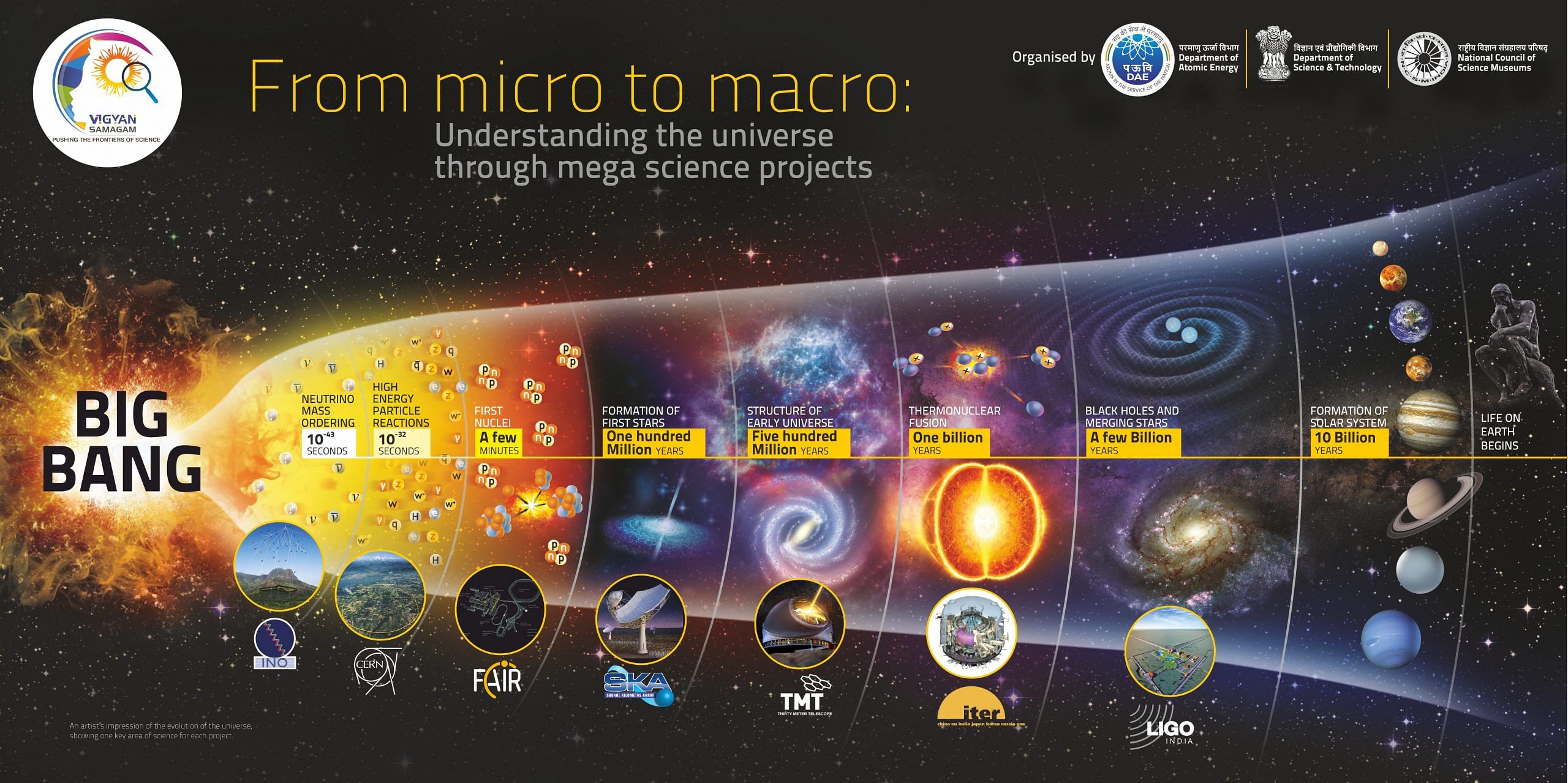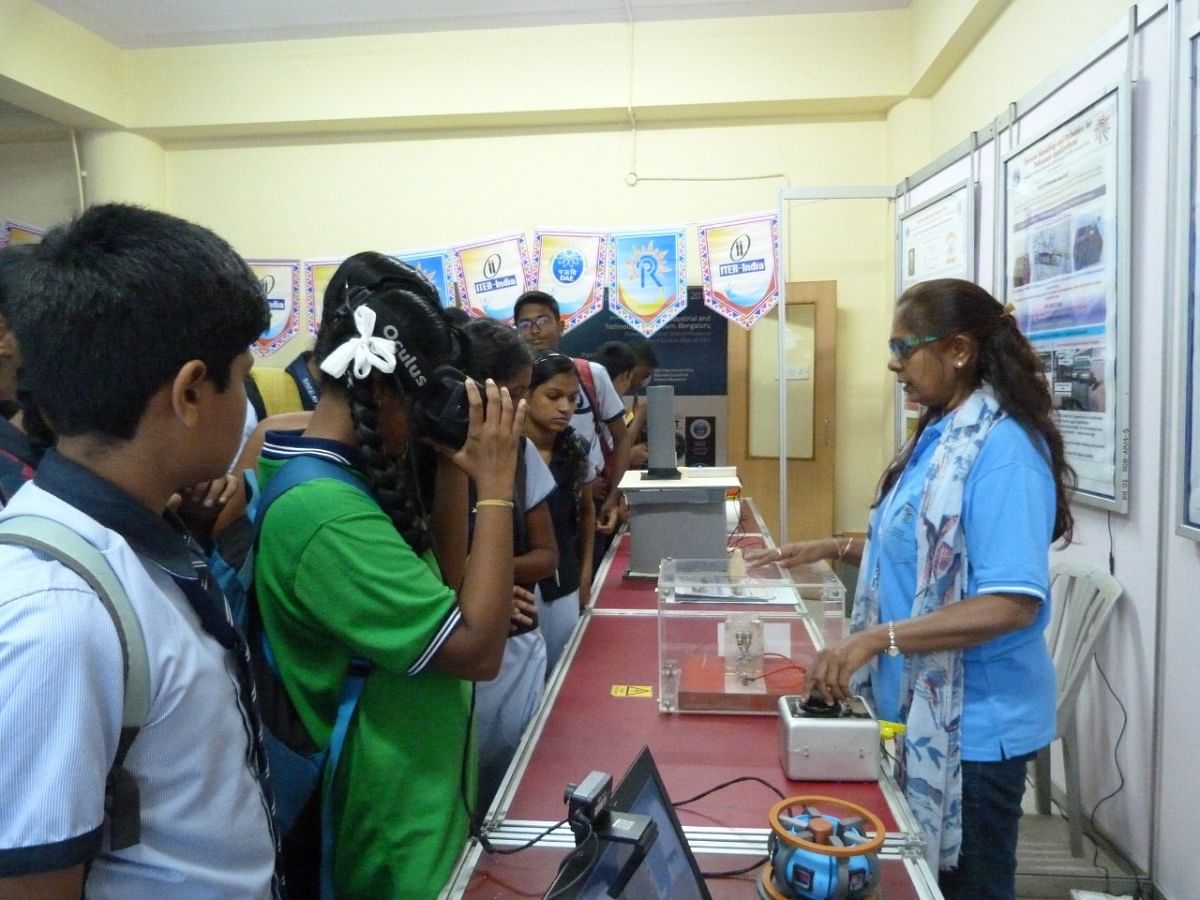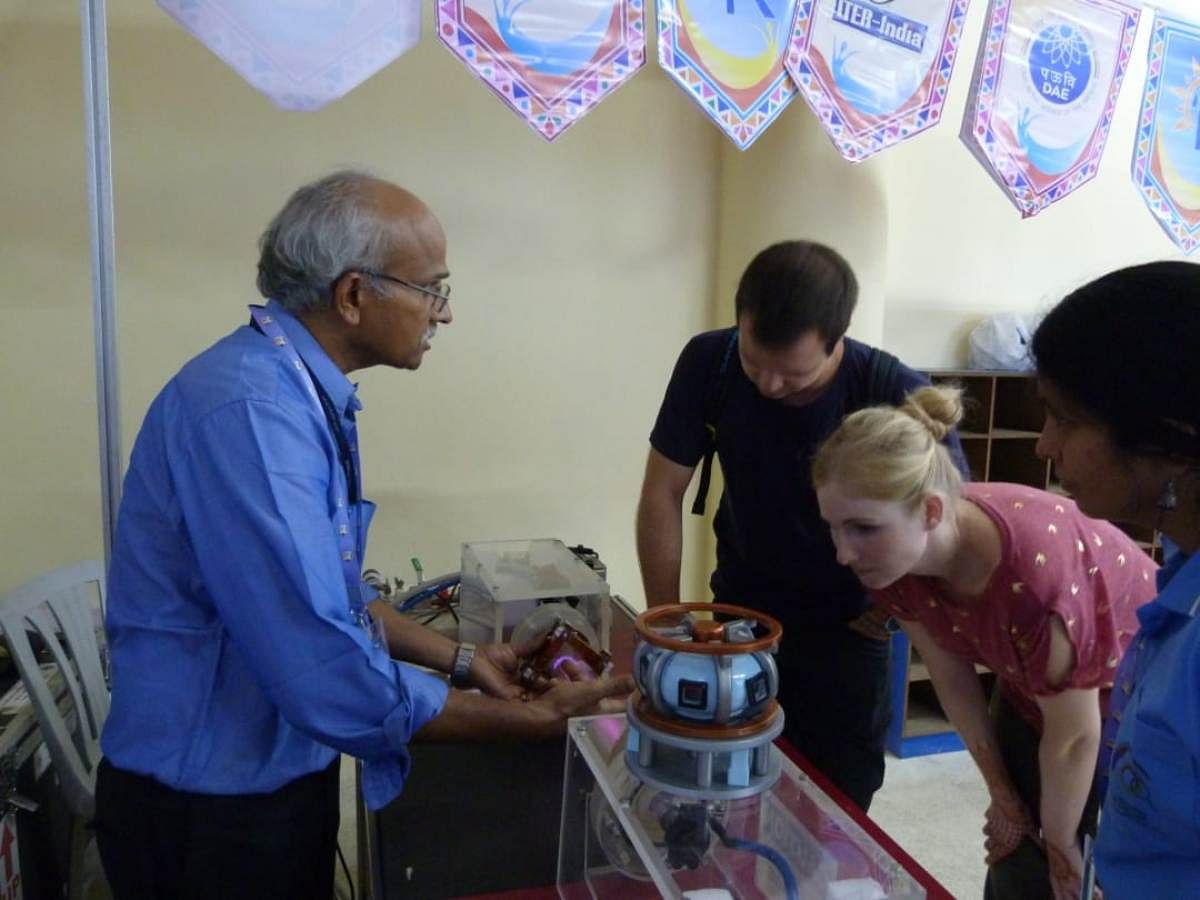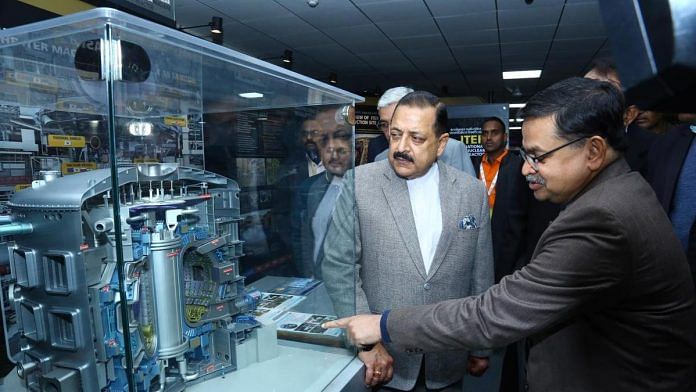New Delhi: Over nine months after it was launched, India’s multi-city travelling mega-science exhibition Vigyan Samagam has now reached the national capital for its final stop.
Looking to bring science closer to society, the event has showcased themed exhibits of seven biggest international mega-science projects, and India’s participation in them across Mumbai, Bengaluru, Kolkata and New Delhi.
Organised by the Department of Atomic Energy (DAE), Department of Science and Technology (DST), and the National Council of Science Museums (NCSM), the event features scientists and volunteers educating and interacting with members of the public, and delivering talks.
For its last stint, Vigyan Samagam reached the National Science Centre in Delhi on 21 January. The exhibition is open to all members of the public on all seven days of the week. It will wrap up on 20 March. More details are available here.

ThePrint takes a comprehensive look at the science behind the real-life projects that are being exhibited and India’s connection with them.
What is mega-science?
Mega-science projects are high-budget global experiments that involve thousands of scientists and make fundamental breakthroughs in science. These projects attempt to answer some of the most basic yet inexplicable questions of our universe, such as how the universe was born, what prompted the formation of stars and galaxies, and if there is life outside of earth.
Vigyan Samagam is showcasing Indian science community’s participation in seven such projects: European Organisation for Nuclear Research (CERN)’s Large Hadron Collider (LHC); Facility for Antiproton and Ion Research (FAIR); India-based Neutrino Observatory (INO); International Thermonuclear Experimental Reactor (ITER); Laser Interferometer Gravitational-Wave Observatory’ (LIGO); Thirty Meter Telescope (TMT) and Square Kilometre Array (SKA).
While each mega-science project at Vigyan Samagam has diverse goals and requires different approaches, together they attempt to unlock one fundamental question — how did the universe burst into existence?
From the story of the Higgs-Boson particle, gravitational waves from mergers of black holes and neutron stars, to the origin of the Universe and the Big Bang theory, the evolution of stars, the Vigyan Samagam exhibition intends to take visitors through the discoveries that have helped humankind understand the universe so far using modern science.
“The exhibition will have theme-based galleries of posters, working models and exhibits, informative audio-visual content and electronic displays and interactive kiosks will be setup for each of the Mega Science Projects,” Arun Srivastava, chief of DAE’s Institutional Collaboration and Program Division, had said in a statement in May.
The statement came ahead of the exhibition’s launch in Mumbai. The event was then held in Bengaluru and Kolkata.
Also read: Two satellites missed a close smash in space — but how did we reach this disaster
Large Hadron Collider
What we see around us today and the classical laws of physics cannot explain what happened when all the energy and matter of the universe was clumped together in tiny, dense point of singularity. All known laws of physics breakdown at a singularity, making it extremely difficult to understand how matter behaves there.
The Large Hadron Collider (LHC) is a fundamental physics experiment that enables microscopic particles to collide at high speeds, and the results observed.
Hadrons are subatomic particles held together by what is known as the ‘strong force’, which is one of the four fundamental forces described in physics (after gravitation, electromagnetism, weak force). When particles are accelerated to high speeds and then allowed to collide, they produce byproducts (which are also subatomic particles).

Such collisions are recreated in the world’s largest and most powerful accelerator — the LHC. It is a ring-shaped vacuum tube, 27 km in circumference and situated 175 metres beneath the French and Swiss border. It is considered to be the largest machine in the world. It is housed inside an underground tunnel that is lined with superconducting magnets that boosts the energy of colliding particles.
Its construction took ten years and was completed in 2008. Today, over 10,000 scientists from more than a hundred countries work on the accelerator and related research.
The entire vacuum tube sits on sophisticated precision magnetic positioning jacks that were supplied by India. The country has also supplied superconducting magnets for the project. India’s DAE signed a cooperation agreement with CERN in 1991, and in 1996, establishing a protocol for collaboration in the LHC project.
“A plethora of technologies is already available, for example, at CERN, in majorly three sectors — accelerator, detectors and computing. They have been successfully used for various societal applications,” Archana Sharma, a CERN scientist, wrote in an article for ThePrint.
Also read: Scientists record first video of atoms forming and breaking chemical bonds
India-based Neutrino Observatory
The government-owned India-based Neutrino Observatory (INO) is aimed at studying the properties and interactions of the elementary particle called neutrino.
Neutrinos are neutral particles a million times lighter than the electron, and interact so weakly with matter that it is very difficult to detect them. However, these are thought to have been the very first particles to escape from the Big Bang, as at high energies, neutrinos possibly displayed much stronger interactions.
Studying neutrinos can help better understand what happened in the very first moments of the Big Bang.
Currently in building stage, the INO will comprise a laboratory in a cavern in a Tamil Nadu mountain, accessed by a 2-km long tunnel, and a rock cover of about 1000 metres. This isolates the lab from other types of cosmic rays, allowing highly sensitive detectors to study neutrinos.
The experiment aims to estimate the ordering of the mass of these neutrinos, i.e., understand neutrino masses from lightest to heaviest. “Our goal is to build a 51 kiloton Iron Calorimetre to detect these neutrinos,” INO project director Vivek Datar told ThePrint.

The Iron Calorimetre consists of 56 mm iron slabs and particle detectors arranged in 150 horizontal layers.
“Being an underground lab it can also serve other purposes. We also intend to conduct experiments to look for dark matter. We also wish to do geophysics experiments there too,” Datar said.
Apart from the search of the elusive neutrino, constructing the detector will itself prove to be a capacity building exercise for India. “We will also be making about 30,000 charged particles glass detectors. This is about four to five times the number of such detectors in the world,” said Datar.
Also read: Einstein’s contempt for peer review wasn’t misplaced, it is something of a lottery
Facility for Antiproton and Ion Research
Just after the Big Bang occurred, conditions became ideal for the building blocks of matter — the quarks and electrons — to be formed. But time scales work in billionth of trillionth of a second, and even smaller during this stage of the universe’s existence. A few millionths of a second after the Big Bang, quarks aggregated to produce protons and neutrons. Within milliseconds, these protons and neutrons combined into nuclei.
Yet scientists do not understand the physics that let matter as we know today emerge.
The Facility for Antiproton and Ion Research (FAIR) is one of the largest international research facilities in the world being built at Darmstadt, Germany. The project brings together 3,000 scientists from 50 countries to study the structure of matter and its evolution.
The facility will be the biggest radioactive beam accelerator facility in the world. It will recreate the extreme conditions such as high temperatures, pressures and densities by bombarding samples of matter with particles. The construction of the project started in 2017 and the facility will likely start operating by 2025.
About 550 magnets of up to 1.6 Tesla will be required for this facility, each of which will need a power converter. The key component of FAIR is a ring accelerator with a circumference of 1,100 meters. The entire facility spans over a site of 20 hectares.
Samit Mandal, a faculty member of Delhi University and one of the member scientists at FAIR, said, “Our Industries are involved to supply all those power converters. Around 80 have already been supplied.
“The vacuum chamber required in this project is very unique, which we are building in India with collaboration of German scientists. Two of them have already been sent for testing.”
The vacuum chamber’s internal pressures will be extremely low to ensure that no unwanted particle interacts with the radioactive beam. “We are also proposing to build a big superconducting magnet of the order of 6 to 7 Tesla,” Mandal said in an interaction with reporters.
The findings from the project are expected to yield next generation spin off technologies in the field of medical imaging. The research could also help develop nuclear batteries that would have the capacity to store much more power than lithium-ion batteries.
Also read: First highest-resolution images of Sun are here, reveal never-seen-before features
Square Kilometre Array
About three minutes after the Big Bang, the universe began to cool, allowing protons and electrons to form neutral hydrogen. About 250 million years after the Big Bang, the first stars of the universe are likely to have formed, made mostly of lighter elements such as hydrogen and helium.
This cosmological dawn before the star formation was dark and invisible, but was buzzing with radio signals. To see what happened when the first galaxies formed, the 13-nation led Square Kilometre Array (SKA) will probe radio signals from the past.
The construction of the SKA will start in 2021, and the facility is expected to start operating by 2025.
The SKA will be an array of telescopes, spread over hundreds of kilometres across two continents. In the first phase, there will be about 200 dishes in South Africa’s Karoo region, and over 130,000 low frequency antennas in western Australia’s Murchison Shire.
Anjan Ananda Sen, an SKA member scientist and a professor at Jamia Millia Islamia, said, “One of the scientific goals that we have is understanding the expansion of the universe. We don’t know the nature of dark energy, and with SKA we might ultimately understand it.
“One of the biggest contributions from the Indian side is the Telescope Manager, which will control, manage and troubleshoot all the dishes and antennas. You can think of it as the brain and nervous system of the telescope,” he added.
The Telescope Manager includes all hardware and software necessary to control the telescope and associated infrastructure. It will help schedule telescope operations, monitor key performance metrics and transmit data from remote locations.
Thirty Meter Telescope
Light signals from some of the earliest galaxies continue to reach the Earth today, making it possible to peer into the past and see what the structure of the early universe was like five hundred million years ago.
The Thirty Meter Telescope (TMT) is the world’s largest and most advanced ground-based optical and infrared observatory.
Currently being built by scientific institutes and organisations from Canada, China, India, Japan and the US, the TMT will be made of 492 individual hexagonal segments which will work together as a single reflective surface of 30 metre diameter. Such large dimensions mean that they will provide unprecedented light gathering capability.
Shashi Bhushan Pandey, a scientist at Nainital-based Aryabhatta Research Institute of Observational Sciences (ARIES), told ThePrint, “India is contributing to this project both in cash and in kind. All of the mirror segments will be polished in India. Some of the mirror segments will be provided by India.”
The software for this project has already been developed in India and has passed the initial review.
However, the construction of the telescope has been delayed. The site of construction is the Mauna Kea mountain, which from its underwater base to summit is the tallest mountain in the world. Mauna Kea is also considered to be the most sacred mountain in Native Hawaiian culture. Over the past five years, the islanders have protested at the site, blocking roads and keeping construction crews away.
The project is scheduled to be completed by 2024.
Also read: World’s highest and India’s largest gamma-ray telescope to go live in Ladakh this year
International Thermonuclear Experimental Reactor
The ambitious International Thermonuclear Experimental Reactor (ITER), being built in Provence in southern France, is set to become the largest fusion experiment in the world.
Under the project, the tokamak, a magnetic fusion device performing the experiment, is built to study and prove the feasibility of atomic fusion as a large-scale clean energy source free of carbon. It aims to function similar to a star, performing the same kind of fusion that occurs in these stars. The larger the volume of the vessel, the larger the volume of plasma — superheated gas — offering scope for increased probability of fusion energy.
The reactor has been designed to produce a power output of 500 MW with an input of 50 MW resulting in a tenfold gain. An average household in the US consumes around 2,000 KW a year.
The project is funded and run by seven member countries: European Union, India, Japan, China, Russia, South Korea, and US. India contributes 9 per cent of the $14-billion construction cost.
The goal of ITER is to demonstrate the scientific and technological feasibility of fusion energy for peaceful use. The construction is expected to be completed by 2025.
“This experiment deals with energy for the future. It will try to replicate how our suns and stars produce energy. We are trying to conduct nuclear fusion on Earth by using isotopes of hydrogen — Deuterium and Tritium,” said Ravi A.V. Kumar, scientific officer at Ahmedabad-based Institute of Plasma Research.
“This will be a stepping stone to harness power from a fusion machine. This machine will produce 10 times more power than what you put in,” said Kumar, who is involved in the ITER project. Currently the nuclear power plants harness energy from fission reactions.
“Once this initial machine is successful, the next step will be a demo reactor that will actually produce electricity.”
India’s biggest contribution to this project will be the cryostat, a device used to maintain low temperatures which encloses the entire machine.
“It will be about 30 m wide and 30 m tall and will require 500 tonnes of steel. This is being built entirely in India by Larsen and Toubro in Gujarat and will be shipped to France,” Kumar said.
At the end of the project, India will also have access to the intellectual property rights to build its own fusion reactor.
Also read: Earth’s oldest-known impact crater, formed 2.23 bn yrs ago, is in Australia: Geologists
Laser Interferometer Gravitational-Wave Observatory
Laser Interferometer Gravitational-Wave Observatory (LIGO) is the mega-science project that gave us a completely new way of doing astronomy and studying objects millions of light years away: gravitational waves.
Gravitational waves are produced when very dense masses move around on the fabric of spacetime. When two extreme bodies like black holes or neutron stars are on a collision course with each other or have collided, they send ripples through spacetime, much like a stone produces when thrown into a still pond. These waves that expand and contract space are so small and so weak that they’re ten-thousandth the diameter of a proton.
LIGO observatories consist of two intersecting, perpendicular arms 4-km long each. At the intersection is a source of light that is split and travels through both arms. At either ends of the arms are mirrors that reflect the light back.
When a gravitational wave hits the arms, space expands ever so slightly, throwing the light’s wave out of whack. This disturbance can be observed and measured. Once a rough source area is located, telescopes operating on other wavelengths such as ultraviolet or infrared can then tune in and study the ‘afterglow’ of mergers.
The more observatories there are, the better and quicker we can triangulate the location of the source event.
LIGO has two observatories in the US — one in Hanford, Washington and the other in Livingston, Louisiana. There is another observatory in Italy, near the city of Pisa, called the Virgo Interferometer. KAGRA in Japan was completed in 2019. The US and Virgo observatories together, in their ‘advanced’ upgraded run, detected the first gravitational wave in 2016.
“The first detection of gravitational waves in 2015 led to a new era of astronomy. It is a window to the universe where we are able to ‘hear’ the vibrations of space apart from seeing the light from various sources,” said Suresh Doravari, research faculty (STO-F R&D) at the Inter-University Centre for Astronomy and Astrophysics, Pune.
There are other proposed gravitational wave observatories, but under LIGO, a new one is on track to being built in India.
“LIGO-India is the third detector of the network and will greatly enhance the capability of understanding the physics and test our theories of extreme gravity. It will improve the localisation of the sources in the sky,” said Doravari.
“This localisation enables multi-messenger astronomy where in other telescopes in the optical, radio and gamma ray wavelengths can synchronise observations and improve our understanding of these astrophysical events,” he said.
There are thousands of scientists working on all LIGO observatories. The first gravitational wave detection was awarded the Nobel Prize, and the paper on the detection included thousands of scientists, including a number of Indians.
Also read: How augmented reality can help create sustainable, environment-friendly smart cities
Future returns for India’s investment in mega-science
Working in mega-science projects is giving Indian academia and industries an opportunity to take up scientific and engineering challenges never attempted before. In doing so, the country is becoming part of a global ecosystem that is driving technological innovations that may eventually transform our everyday lives.
A 2019 report by the European Physical Society (EPS) said physics-based industries generate over 16 per cent of total turnover in Europe, exceeding contributions from the financial services and retail sectors.
According to CERN’s Archana Sharma, mega-science projects could help India achieve its goal of becoming a $5-trillion economy.
However, Arindam Ghosh a professor at Indian Institute of Science, Bengaluru told ThePrint that it may not be enough to invest in mega-science for the country to reap economic benefits.
“The mediator which translates the mega-science outcomes to eventual commercialisation of industrial products is missing in India,” he said.
“Unless the government spends serious amount of money and attention to develop these infrastructure, mega science projects will remain an isolated component of some scientific curiosity,” Ghosh added.
Also read: Indian research team sets sail to Antarctic Ocean to study climate change




